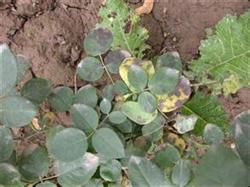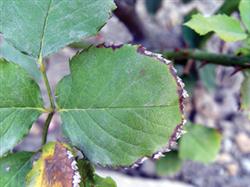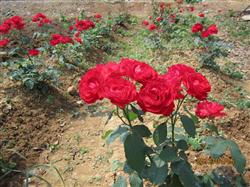Common diseases of rose and their control

In modern production, suitable greenhouse conditions, such as installing anti-insect nets and strengthening the ventilation environment in the greenhouse, can prevent more than 90% of diseases and insect pests. The equipment of professional plant protection technicians and the daily monitoring of all workers are the key to early detection and control of diseases and insect pests in the early stage. 1. Root cancer: root cancer is a major disease for producers in countries without cold winters and is common in Asia, Africa, Australia and India. It is said that root cancer is caused by rootstocks, but it may also exist in the soil and attach to the host when the seedlings are planted. Control measures: chemical control and the use of resistant rootstocks can only play a role in control to a certain extent. The only way to prevent root cancer infection is to use soilless cultivation or to buy root rootstocks from frosty areas. Daily control is to disinfect the seedbed soil, plant resistant rootstocks or carry out soilless cultivation before planting. two。 Downy mildew: downy mildew is a headache for every tropical rose producer, often in low temperature, humid weather and lack of ventilation around the plant. The leaves will turn yellow after black spots, and the leaves will fall off after a period of time. Downy mildew can cause great damage to rose and lead to a serious reduction in production in a short period of time. The precaution is to keep the leaves dry, especially at night when the temperature drops. Apart from improving ventilation, there are few treatments. For rose, downy mildew that comes with low temperature is not as common as powdery mildew that comes with high temperature. Prevention and control measures: no preventive agents can be used to prevent downy mildew. When the plant is susceptible, the drug should be sprayed three times at intervals of 4 to 7 days. The names of the drugs are biphenyl triazole (150 ml / 100 L water), Lobigeng (25 to 35 ml / 100 L water), and chloramphenicol (100 ml / 100 L water). These are all products with the same chemical composition. Products with other chemical components should be sprayed three times when reinfected with downy mildew, the drug name is ethosulfonate (concentration 200 to 300 ml / 100 L water), dodecyclomorpholine (concentration 200 to 250 ml / 100 L water), benzene preparation fungus. During periods of very high relative humidity (> 90%) at night, it is recommended to use sulfur once a week to prevent downy mildew. The periods most likely to be infected are during the rainy season and when cooling is needed at night. Use a sulfur fumigator once a week, using about 300g to 500g of sulfur per 1000 square meters. 3. The pathogen of anthracnose is Elsinoerosarum. The pathogen infects all parts of the aboveground part of the rose plant. On the leaves, the lesion is nearly round and about 6 mm in diameter. In the early stage, the spot is purplish brown with a light brown edge. In the later stage, the center of the lesion turns gray and often falls off. The plaque is uniformly black with irregular radiating edges. In general, anthrax does not have much effect on the growth of rose. 4. The pathogen of black spot is Diplocarponrosae. Rose black spot is a worldwide disease with serious harm. The pathogen mainly harms leaves, twigs and pedicels. After the leaf was infected, the leaf surface appeared purple-black round spot, or irregular (radiation) spot. The edge of the lesion is purplish brown or reddish brown, radial. There are many black microsomes on the lesion, that is, the conidial disc. Plaques are often linked together. The mesophyll around the disease turned yellow in a large area, and the spot became an "island" with a green edge. Diseased leaves fall off easily. When the disease occurs seriously, the leaves of the lower part and even the middle part of the whole plant fall off. The asexual stage of bacteria is the most common. The conidia are placed under the host epidermis and break through the epidermis when they mature. The spore disk is black and arranged in a wheel shape. The conidia are short, the conidia are oval or long oval, colorless, bicellular, and the sizes of the two cells are different. Black spot pathogen overwintered on diseased plants or fallen leaves with mycelia or conidia. Conidia are spread by Rain Water or sprinkler water splash, and insects can also spread. Under moist conditions, the conidia on the leaves could germinate and invade directly within 6 hours. The incubation period is 7 to 10 days. It is easy to get sick in rainy, foggy and dewy weather. The newly transplanted plantlets have few roots and weak plants, so they are easy to suffer from the disease. There are great differences in disease resistance among rose varieties, and light-colored flowers, small flowers and erect varieties are susceptible to disease. Prevention and control measures: clean the fallen leaves on the ground at any time, thoroughly clean the fallen leaves and burn them after autumn. Re-pruning measures were used for overwintering plants. Strengthen the cultivation management, especially the fertilizer and water management of newly planted small plants, so as to improve the disease resistance of plants. Planting or breeding disease-resistant varieties. In the early stage of growth, chemical control should be strengthened to prevent the infection of bacteria, such as spraying 1000 times of 50% Dysenamine, 1000 times of 50% carbendazim, Bordeaux solution, etc. Improve watering facilities and control insects to reduce the spread of germs. 5. The pathogen of Botrytis cinerea is Botrytis cinerea Botrytiscinerea. After the bud was infected by Botrytis cinerea, the bud turned brown and rotten. When the flowers are in bloom, individual petals become brown and wrinkled. The disease is prone to occur on old flowers that have not been picked, especially in wet conditions and rainy seasons. When the disease is serious, the opening of the flower organ is hindered. In winter, there is Botrytis cinerea on the withered stem of rose. Prevention and control measures: timely removal of diseased flowers, removal of withered presbycis, and concentrated burning. Spraying chemical drugs at the initial stage of plant growth, such as 1000 times solution of 70% Fumei and 1000 times solution of 50% benzoate, can be effectively prevented. 6. The pathogen of powdery mildew is Rosa monomycetes (Sphaerothecapannosavar.rosae). Rose powdery mildew is a common disease. Powdery mildew can infect leaves, petioles, buds and shoots. In the early stage, there are chlorotic maculae on the diseased leaves, gradually enlarged, and the edge is not obvious. There is a layer of white powder on the leaf back disease spot. After the young leaves are infected, the leaves are easy to rewind, wrinkle, thicken, and sometimes become purplish red. When the petiole and tender tip were infected, the injured part was slightly inflated and bent in reverse. When the flower bud is infected, the surface is covered with powdery mildew layer and the flower posture is deformed. When the plant is seriously susceptible to disease, the leaves are yellowed, wrinkled and shedding. When the old leaves fall off, the new leaves will continue to suffer, resulting in plant weakness, abnormal flowering or failure of flowering, losing ornamental value. Powdery mildew overwintered on diseased buds, diseased leaves or diseased branches in the form of mycelium, and some overwintered in the form of closed capsule. In the second year, the bacteria began to move with the germination of the buds, infecting the young parts, producing new spores and spreading by means of wind power. The bacteria can be continuously re-infected during the growing period of the rose. Powdery mildew occurred more frequently in spring (May to June) and autumn (September to October) in open field cultivated rose, which was the peak period. The damage in the northern region is mainly in spring and less in autumn. If rose is cultivated in greenhouse, powdery mildew can occur every year. Powdery mildew can be harmed when the room temperature is above 5 ℃. The disease is more serious when the temperature is high, the humidity is high, the heat is muggy and the ventilation is poor. There were significant differences in disease resistance among rose varieties. In general, bare-leaf, trailing, many-flowered varieties are more resistant, but most rose varieties are susceptible. Prevention and control measures: when planting rose in greenhouse, we should pay attention to ventilation and control humidity, so as to control the disease conditions. Strengthen fertilizer and water management and improve disease resistance. Small area or family cultivated rose should be carefully examined for diseased buds and diseased leaves, cut off and destroyed in time. Chemical fungicides should be sprayed in disease areas or diseased plants for prevention and control. Spray Bordeaux solution (1-100-200) and 3-4 Bordeaux-sulphur mixture before germination. During the growth period, 50% Dysenamine 1000-fold solution, 70% methyl topiramate 800-fold solution, 50% carbendazim 800-fold solution, 50% benzoate 1000-fold solution. Spraying 200-fold solution of non-toxic high-fat membrane has a good effect on the prevention of powdery mildew and the initial treatment of powdery mildew. After prevention and treatment with high-fat membrane, there is no drug mark on the leaf surface, which is beneficial to ornamental and environmental protection. When cutting and propagating rose, carefully select disease-free branches as cuttings and disinfect them with chemicals before cutting. When producing rose in large quantities, seed collection and planting areas should be established to seriously control powdery mildew and continuously supply disease-free cuttings. 7. The pathogen of rust is polycytic rust (Phragmidiummucrona-tum). Rust can harm leaves, petioles, stems, flower stalks and buds. Orange summer spore piles can be produced on leaves and stems, and later dark brown teliospore piles can be produced. When it is serious, the back of the leaf is covered with a layer of yellow powder, and the leaf is scorched and falls off early. The pathogen overwintered on the host tissue in the form of winter spores and hyphae. The disease occurs from August to September every year. Planting is too dense, low-lying, soil viscosity, consolidation, barren and other conditions are conducive to the occurrence of rust. Prevention and control measures: diseased leaves and branches are removed and destroyed in time. Strengthen cultivation management, planting or placement should not be too dense, frequently remove weeds, ditch drainage and so on. Spray 3-4 Baomedo stone sulfur mixture before germination in early spring. The growing season can be sprayed with 300-fold solution of diphacinone, 800-fold solution of 15% trimethoprim, 800-fold solution of 50% acetaminophen, and 800-fold solution of 50% Dysenamine. 8. The pathogen of mosaic disease is rose mosaic virus (Rosamosaicvirus). The virion is spherical, about 25 nanometers in diameter. The lethal temperature of virus was 54 ℃. The in vitro survival time (at room temperature) was 6 hours. The virus can infect hops naturally. Inoculating with the sap of susceptible plants can infect 25 species of plants from 7 families, such as Catharanthus roseus, watermelon, tricolor flower, cucumber, melon bean, heart leaf tobacco, petunia and so on. The virus can be transmitted by grafting and juices. The host plants can be diagnosed as Huanghua tobacco (light system chlorotic spot), melon bean (local withered spot), Catharanthus roseus (systematic chlorotic ring spot), cowpea (systematic chlorotic ring spot) and so on. After the rose was infected with the virus, irregular yellowish or orange patches appeared on the leaves, sometimes showing systematic ring spots and oak leaf markings. Some varieties will appear different degrees of yellow vein band and dwarfing. Prevention and control measures: careful examination of diseased plants, the symptoms of susceptible plants in spring are obvious, so spring investigation should be strengthened. Diseased plants can not be used for reproduction, should be marked down, it is best to eliminate or destroy. The virus on the susceptible plant can be eliminated by heat treatment, because the virus in the plant can be completely eliminated after being maintained in 38 ℃ constant temperature and hot air for 4 weeks.
- Prev

Identification and control of black spot of rose
The disease is common and does serious harm, resulting in a large number of fallen leaves of rose and huge losses. The pathogen is a fungus of the genus Actinomyces. First, at the beginning of symptom recognition, brown radial plaques appear on the leaf surface, and then gradually enlarge into round or subcircular spots with a diameter of 412 mm.
- Next

How to make rose blossom beautifully
If you want the rose to grow strong, even non-professionals can do a lot of useful work: 1 find ways to create good light for the rose. Photosynthesis is the source of growth and health. Always maintain the good ventilation of the rose, do not plant too closely, and do not let the weeds affect its ventilation. ...
Related
- Fuxing push coffee new agricultural production and marketing class: lack of small-scale processing plants
- Jujube rice field leisure farm deep ploughing Yilan for five years to create a space for organic food and play
- Nongyu Farm-A trial of organic papaya for brave women with advanced technology
- Four points for attention in the prevention and control of diseases and insect pests of edible fungi
- How to add nutrient solution to Edible Fungi
- Is there any good way to control edible fungus mites?
- Open Inoculation Technology of Edible Fungi
- Is there any clever way to use fertilizer for edible fungus in winter?
- What agents are used to kill the pathogens of edible fungi in the mushroom shed?
- Rapid drying of Edible Fungi

